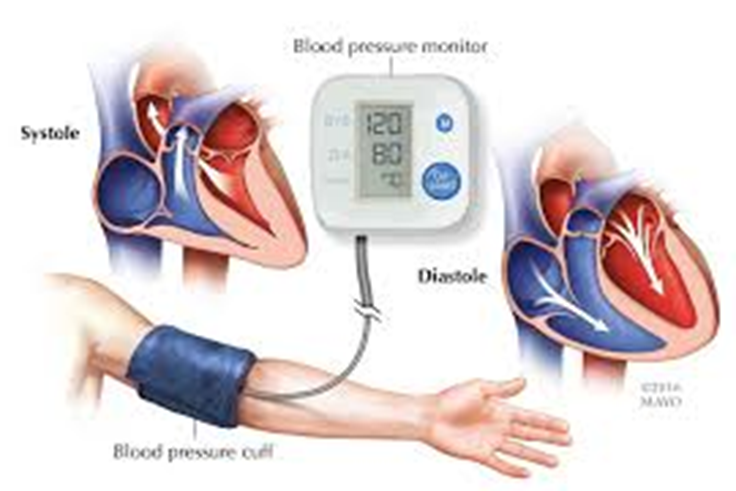A client has arrived at the clinic for a routine physical examination. Prior to assessing the client's blood pressure, what should the nurse do?

Position the arm so that it is below waist level.
Palpate the radial artery to confirm a pulse is present.
Ask the client to sit quietly in a chair for 5 minutes.
Make sure the arm selected is covered with clothing.
The Correct Answer is C
Choice A Reason:
Positioning the arm below waist level is not recommended when measuring blood pressure. It can result in an inaccurate reading, typically showing a higher blood pressure due to the effects of gravity on the blood column. The arm should be positioned at heart level for an accurate measurement.
Choice B Reason:
While palpating the radial artery to confirm a pulse is present is part of the overall assessment of circulation, it is not a necessary step immediately before measuring blood pressure. The focus should be on ensuring the client is in the correct position and is relaxed to avoid any factors that might artificially alter the blood pressure reading.
Choice C Reason:
Asking the client to sit quietly in a chair for 5 minutes is the correct procedure before measuring blood pressure. This allows the client's heart rate and blood pressure to stabilize, providing a more accurate measurement. Any activity or stress can temporarily raise blood pressure, so this quiet time is crucial.
Choice D Reason:
The arm selected for blood pressure measurement should not be covered with clothing. Clothing can constrict the blood pressure cuff and interfere with the accuracy of the reading. The cuff should be placed on bare skin to ensure it inflates and deflates correctly and that the stethoscope can accurately detect the sounds of the blood flow.
Nursing Test Bank
Naxlex Comprehensive Predictor Exams
Related Questions
Correct Answer is ["A","C","D"]
Explanation
Choice A Reason:
Assessing vital signs is crucial for evaluating the client's responses to treatment. Changes in vital signs can indicate whether the body is responding positively or negatively to a treatment, allowing healthcare providers to adjust care plans accordingly. For example, a decrease in fever after administering antipyretics would suggest the treatment is effective.
Choice B Reason:
While carrying out orders from the healthcare provider is a responsibility of the nurse, it is not the primary reason for assessing vital signs. Vital signs are assessed to inform clinical decisions, not solely to fulfill orders. Therefore, this choice is not correct in the context of the importance of vital sign assessment.
Choice C Reason:
Monitoring risks for alterations in health is another key reason for assessing vital signs. Vital signs can serve as early indicators of health issues, such as the onset of an infection indicated by a rising temperature or cardiovascular problems suggested by changes in blood pressure or heart rate.
Choice D Reason:
Establishing a baseline is essential when assessing vital signs. It provides a reference point for future comparisons, which is important for detecting any deviations from the client's normal range. This helps in identifying potential health issues early and monitoring the progression of known conditions.
Correct Answer is B
Explanation
Choice A reason:
Discussing reactions to allergens typically focuses on environmental or food triggers that may cause allergic reactions. While it's important to understand a client's allergies, this topic is not closely related to alcohol use, which has different implications for health and lifestyle choices.
Choice B reason:
Asking about alcohol use naturally follows the discussion about cigarette smoking because both involve substance use and have potential health risks. It allows the nurse to transition smoothly from one lifestyle factor to another, which can impact the client's overall health. This approach also helps in creating a comprehensive picture of the client's habits that may contribute to or affect their current health status.
Choice C reason:
Reviewing current medications is an essential part of the health history, as it can reveal potential interactions with alcohol. However, it might be more appropriate to ask about alcohol use after discussing other lifestyle habits such as smoking, as they are more directly related. Once the client's substance use habits are established, the nurse can then discuss how these might interact with prescribed medications.
Choice D reason:
Asking about previous surgeries is important for understanding a client's medical history, but it is not directly related to the client's current lifestyle habits like alcohol use. Therefore, it would be more natural to ask about alcohol use in the context of other substance use discussions rather than after surgical history.
Whether you are a student looking to ace your exams or a practicing nurse seeking to enhance your expertise , our nursing education contents will empower you with the confidence and competence to make a difference in the lives of patients and become a respected leader in the healthcare field.
Visit Naxlex, invest in your future and unlock endless possibilities with our unparalleled nursing education contents today
Report Wrong Answer on the Current Question
Do you disagree with the answer? If yes, what is your expected answer? Explain.
Kindly be descriptive with the issue you are facing.
